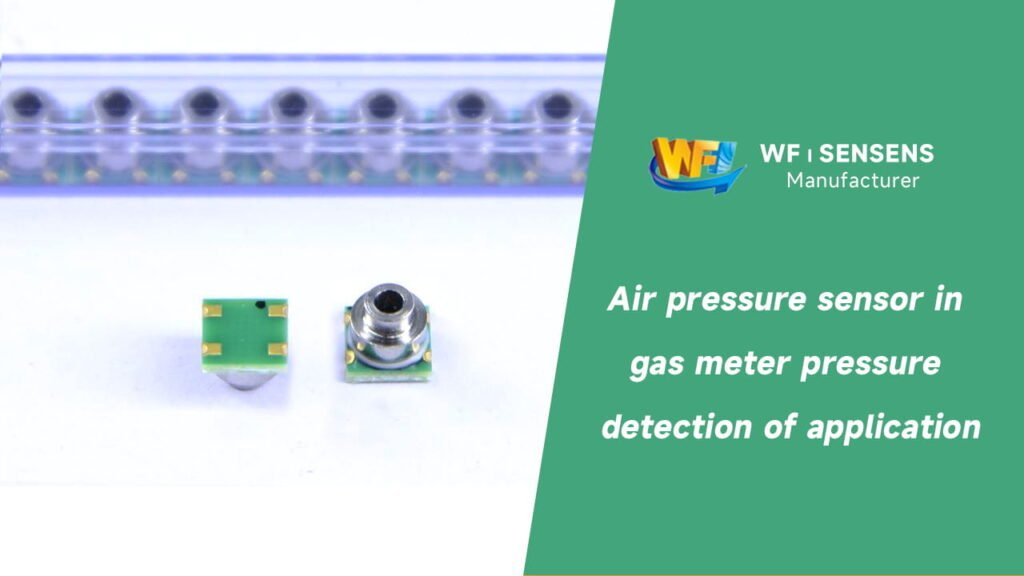
Katalog
With new home gas safety regulations requiring pressure indication in gas meters, the WF5805F high-precision MEMS pressure sensor integrates temperature and pressure detection for next-generation gas meter designs. This compact SMD sensor features 24-bit ADC, ultra-low power consumption, and a wide 1-2bar measurement range with 0.02mbar accuracy for reliable battery-powered gas meter applications.
1. Gas Meter Pressure Monitoring Requirements Under New Regulations
Safety Significance of Gas Meter Pressure Detection
New home gas safety regulations mandate pressure indication in gas meters due to safety concerns from abnormal pipeline pressures. The WF5805F sensor addresses this requirement with real-time pressure monitoring, providing accurate data for users and maintenance personnel.
Technical Challenges in Traditional Gas Meter Upgrades
Traditional gas meters lack pressure monitoring capabilities. The WF5805F’s compact SMD package and 3.6V operation voltage enable easy integration into existing designs without major circuit modifications, reducing upgrade costs significantly.
2. WF5805F Core Technical Features Analysis
Integrated Dual-Parameter Detection Design
The WF5805F uniquely combines temperature and pressure sensing, offering significant cost advantages. With ±1°C temperature accuracy, it eliminates the need for separate sensors while saving PCB space and reducing component costs.
High-Precision Measurement System Architecture
The built-in 24-bit ADC ensures high-resolution data with 1-2bar range covering all gas meter applications. The 0.02mbar precision leads the industry, with each sensor undergoing strict factory calibration for plug-and-play operation.
3. Ultra-Low Power Design Engineering Value
Battery-Powered System Design Considerations
The 0.6uA ultra-low power consumption enables multi-year battery operation in gas meters. This design significantly extends maintenance cycles and reduces operational costs for large-scale utility deployments.
EMC and Reliability Assurance
With 2000V ESD protection and -40~125℃ industrial-grade temperature range, the sensor ensures reliable operation in complex installation environments, meeting outdoor gas meter requirements effectively.

4. Simplified Development and Integration Process
Standardized Communication Interface Design
The universal I2C protocol simplifies integration complexity, requiring no register configuration for immediate post-power data reading. This plug-and-play approach significantly shortens product development cycles.
Optimized Data Processing Algorithm Implementation
The four-step data reading process—calibration value retrieval, ADC data acquisition, offset calculation, and output calibration—efficiently balances processing speed and accuracy requirements.
5. Market Applications and Technology Development Trends
Digital Transformation of Gas Meter Industry
The WF5805F’s widespread adoption reflects the industry’s shift toward intelligent, digitalized gas meters. Modern meters integrate multiple sensors for comprehensive pipeline monitoring, supporting smart city IoT applications.
Technology Standardization and Mass Production Advantages
Standardized packaging and interfaces enable cost-effective mass production. The SMD design ensures high-yield automated assembly, providing reliable component supply for gas meter manufacturers.
Abschluss
The WF5805F pressure sensor represents significant advancement in gas meter pressure monitoring technology. Its integrated dual-parameter detection meets new regulatory requirements while offering cost-effective solutions for manufacturers. The sensor’s high precision, ultra-low power consumption, and simplified integration make it essential for next-generation smart gas meters.
Die obige Einführung kratzt nur an der Oberfläche der Anwendungen der Drucksensortechnologie. Wir werden weiterhin die verschiedenen Arten von Sensorelementen untersuchen, die in verschiedenen Produkten verwendet werden, wie sie funktionieren und welche Vor- und Nachteile sie haben. Wenn Sie detailliertere Informationen zu den hier besprochenen Themen wünschen, können Sie sich die entsprechenden Inhalte weiter unten in diesem Handbuch ansehen. Wenn Sie unter Zeitdruck stehen, können Sie auch hier klicken, um die Details dieser Leitfäden herunterzuladen PDF -Daten des Luftdrucksensorprodukts.
Weitere Informationen zu anderen Sensortechnologien finden Sie hier Besuchen Sie unsere Sensors -Seite.

